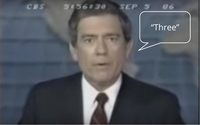 Beginning today, readers may start noticing something
different about our content. Hopefully, it will be better. One thing’s for sure, you’ll be seeing less of it.
Beginning today, readers may start noticing something
different about our content. Hopefully, it will be better. One thing’s for sure, you’ll be seeing less of it.
We are introducing some new processes -- programmatic ones
and people ones too -- that are explicitly intended to do that, limit what you see from MediaPost.
The machine process is pretty simple. It will begin counting every time a story,
commentary or other type of article is distributed in one of our publications -- one... two... three -- and it will put those numbers next to each piece of content so our editors know how many times
we have published it.
The human part is where it gets interesting, because we’re asking each of our editors to look at the content, how many times it has been published, and
decide whether to use it based on our goal of not publishing it more than three times.
We are doing this, because the biggest complaints we hear from you is that we publish too much
stuff. And one way we figured we could leverage programmatic technology was in helping us to frequency cap it. There are other things we are doing to make sure it’s the right stuff, but
that’s a different post. This one is about why and how we are frequency capping our content.
The reason we’re picking three times, is because people on Madison Avenue say
it’s still a good standard for planning optimal frequency of a message. And if you don’t want to read something we’re distributing after being exposed to it three times, that’s
good enough for us.
As I said, this is not entirely a machine rule. It involves the behavior of human beings we believe are best at determining what is optimal for their readers.
Always have, always will.
The reason this is a viable RTBlog -- well, a minimal viable one, anyway -- is that we’re only doing what the programmatic media marketplace is
supposed to do. Use people, machines and data to make media work better for other people. And we like to practice what we preach when we are given the opportunity to practice it.
I
have no idea how big brands, agencies and trading desks actually do this, but we’ll let you know how this works. Actually, you’ll be letting us know. But we’ll let you know what we
learn from you too.
Speaking of changes in how you experience our content, it’s probably a good time to explain some that will begin next week, especially some new people who
will be joining our team. And one who is rejoining it: Tobi Elkin.
It feels funny to write that, because whenever I’ve
thought about Tobi while she was at eMarketer over the past eight years, I’ve still thought of her as being part of the MediaPost team. That’s because she is a fundamental part us -- part
of our DNA. So it’s nice to have her chromosomes back. Even better, she’s going to take over editing this publication, which is a good thing for all concerned.
For you,
it’s because Tobi went to grad school at eMarketer and knows how to shape information about what sometimes are the most complicated and confusing parts of our business. And also because she has
some of the best journalistic skills of anyone I’ve ever worked with. She’s the whole package.
We’ll get more into that package next week, but it’s not going
to include any less of me. If you couldn’t already tell, I geek out on this stuff. It’s my favorite thing to cover. I’m not letting go.
But we’re also adding
some other talent to the team, including our first dedicated programmatic beat reporter, Felicia Greiff, who joins us from Ad Age, and Sara Guaglione, who joins us as a publishing industry beat reporter working with Erik Sass on Publishers Daily.
And
let’s not forget Philip Rosenstein, who began as editor of Marketing Politics Daily (um, it’s a limited edition so don’t worry about that frequency capping thing), whom I already
welcomed this week.
Together, they represent some of the next generation of MediaPost’s editorial talent. We’re going to be announcing more of them soon, but since
we’re operating in a real-time world of information, we figured we’d let you know about the changes that are happening now.
As always, give us feedback, criticism,
advice, but please limit it to three.
As for the headline, well, you know, there are only so many times you can use it and mean it literally.